Behavior of an Exponential System of Difference Equations
Abstract
We study the qualitative behavior of the following exponential system of rational difference equations: xn+1 = /(γ + αxn + βxn−1), yn+1 = /(γ1 + α1yn + β1yn−1), n = 0,1, …, where α, β, γ, α1, β1, and γ1 and initial conditions x0, x−1, yo, and y−1 are positive real numbers. More precisely, we investigate the boundedness character and persistence, existence and uniqueness of positive equilibrium, local and global behavior, and rate of convergence of positive solutions that converges to unique positive equilibrium point of the system. Some numerical examples are given to verify our theoretical results.
1. Introduction
Mathematical models of population dynamics have created great interest in the field of difference equations. As pointed out in [1, 2], to model biological phenomenon, discrete dynamical systems are more appropriate than continuous time models, being computationally efficient to get numerical results. Difference equations also appear naturally as discrete analogs of differential and delay differential equations and have applications in finance, biological, physical, and social sciences. Nonlinear difference equations and their stability analysis and global and local behaviors are of great interest on their own. For some interesting results in this regard we refer to [3–6] and the references therein. Exponential difference equations made their appearance in population dynamics. Though their analysis is hard, it is very interesting at the same time. Biologists believe that the equilibrium points and their stability analysis are important to understand the population dynamics.
More precisely, we investigate the boundedness character, persistence, existence, and uniqueness of positive steady state, local asymptotic stability and global behavior of unique positive equilibrium point, and rate of convergence of positive solutions of system (4) which converge to its unique positive equilibrium point.
2. Boundedness and Persistence
The following theorem shows that every solution of (4) is bounded and persists.
Theorem 1. Every positive solution {(xn, yn)} of the system (4) is bounded and persists.
Proof. Let {(xn, yn)} be an arbitrary solution of (4); then
Theorem 2. Let {(xn, yn)} be a positive solution of the system (4). Then, [L1, U1] × [L2, U2] is invariant set for system (4).
Proof. It follows by induction.
3. Linearized Stability
Definition 3. Let be an equilibrium point of the system (8).
- (i)
An equilibrium point is said to be stable if for every ε > 0 there exists δ > 0 such that for every initial condition (xi, yi), implies for all n > 0, where ∥·∥ is the usual Euclidian norm in .
- (ii)
An equilibrium point is said to be unstable if it is not stable.
- (iii)
An equilibrium point is said to be asymptotically stable if there exists η > 0 such that and as n → ∞.
- (iv)
An equilibrium point is called global attractor if as n → ∞.
- (v)
An equilibrium point is called asymptotic global attractor if it is a global attractor and stable.
Definition 4. Let be an equilibrium point of the map
Let be equilibrium point of the system (4); then
Lemma 5 (see [9].)For the system Xn+1 = F(Xn), n = 0,1, …, of difference equations such that is a fixed point of F. If all eigenvalues of the Jacobian matrix JF about lie inside the open unit disk |λ| < 1, then is locally asymptotically stable. If one of them has a modulus greater than one, then is unstable.
The following theorem shows the existence and uniqueness of positive equilibrium point of system (4).
Theorem 6. If
Proof. Consider the following system of algebraic equations:
Theorem 7. If
Proof. The characteristic equation of the Jacobian matrix about equilibrium point is given by
Assuming condition (25) one has
4. Global Character
Lemma 8 (see [11].)Let I = [a, b] and J = [c, d] be real intervals, and let f : I × J → I and g : I × J → J be continuous functions. Consider the system (8) with initial conditions x0, x−1, yo, y−1 ∈ I × J. Suppose that the following statements are true.
- (i)
f(x, y) is nonincreasing in both arguments x, y.
- (ii)
g(x, y) is nonincreasing in both arguments x, y.
- (iii)
If (m1, M1, m2, M2) ∈ I × J is a solution of the system
()
Theorem 9. The unique positive equilibrium point of the system (4) is a global attractor.
Proof. Define f(x, y) = ((α + β)e−y)/(γ + (α + β)x) and g(x, y) = ((α1 + β1)e−x)/(γ1 + (α1 + β1)y). It is easy to see that f(x, y) and g(x, y) are nonincreasing in both arguments x and y. Let (m1, M1, m2, M2) ∈ I × J be a solution of the system
Corollary 10. If condition (25) of Theorem 7 is satisfied, then the unique positive equilibrium point of the system (4) is globally asymptotically stable.
5. Rate of Convergence
In this section we will determine the rate of convergence of a solution that converges to the unique positive equilibrium point of the system (4).
Proposition 11 (Perron’s theorem [12]). Suppose that condition (38) holds. If Xn is a solution of (37), then either Xn = 0 for all large n or
Proposition 12 (see [12].)Suppose that condition (38) holds. If Xn is a solution of (37), then either Xn = 0 for all large n or
6. Examples
In order to verify our theoretical results and to support our theoretical discussions, we consider several interesting numerical examples in this section. These examples represent different types of qualitative behavior of solutions to the system of nonlinear difference equations (4). All plots in this section are drawn with Mathematica.
Example 1. Let α = 90, β = 25, γ = 312, α1 = 2, β1 = 30, and γ1 = 5. Then, the system (4) can be written as
The plot of xn for the system (51) is shown in Figure 1, plot of yn for the system (51) is shown in Figure 2, and its global attractor is shown in Figure 3. The unique positive equilibrium point of the system (51) is given by .
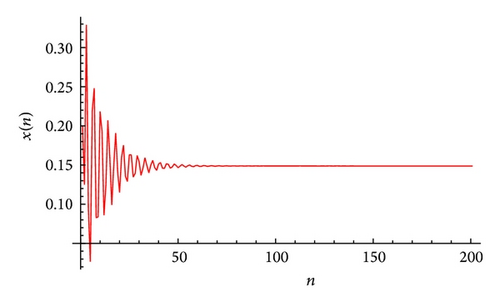
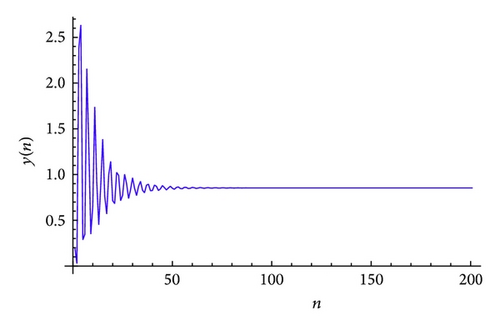
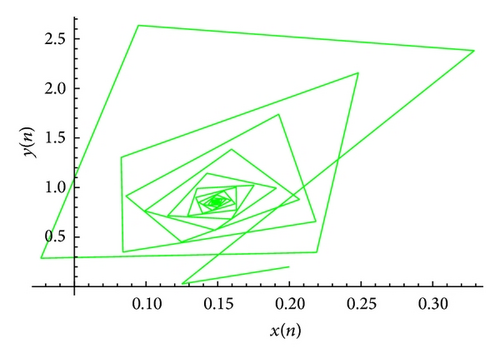
Example 2. Let α = 225, β = 55, γ = 712, α1 = 1.7, β1 = 30, and γ1 = 1.9. Then, the system (4) can be written as
The plot of xn for the system (52) is shown in Figure 4, plot of yn for the system (52) is shown in Figure 5, and its global attractor is shown in Figure 6. The unique positive equilibrium point of the system (52) is given by .
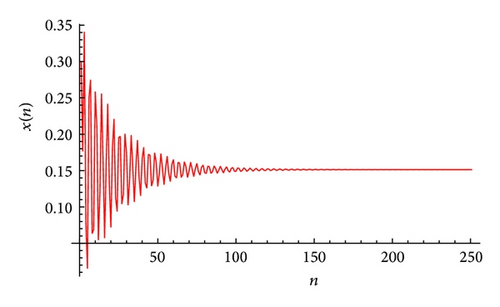
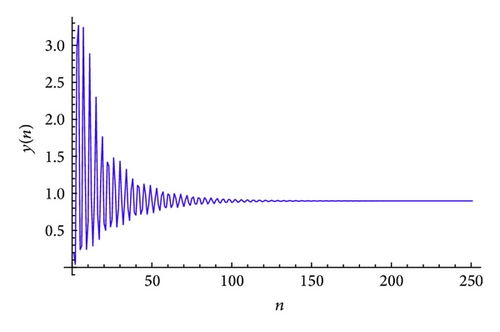
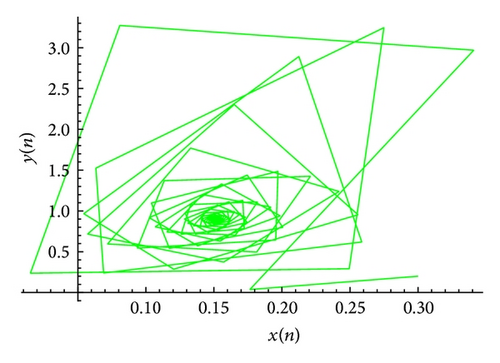
Example 3. Let α = 125, β = 14, γ = 112, α1 = 15, β1 = 32, and γ1 = 0.009. Then, the system (4) can be written as
The plot of xn for the system (53) is shown in Figure 7, plot of yn for the system (53) is shown in Figure 8, and its global attractor is shown in Figure 9. The unique positive equilibrium point of the system (53) is given by .
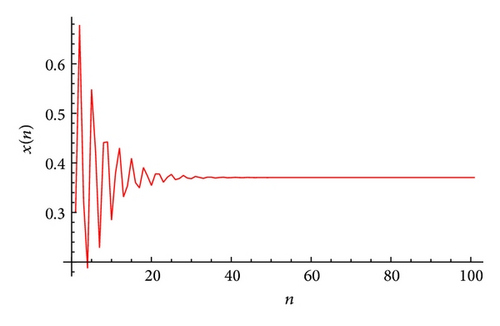
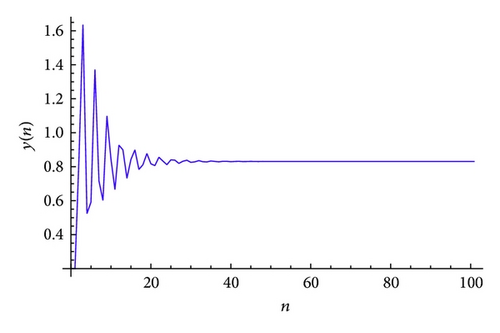
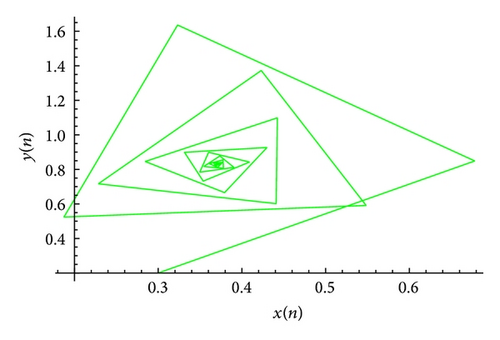
7. Conclusion
This work is related to the qualitative behavior of an exponential system of second-order rational difference equations. We have investigated the existence and uniqueness of positive steady-state of system (4). Under certain parametric conditions the boundedness and persistence of positive solutions are proved. Moreover, we have shown that unique positive equilibrium point of system (4) is locally as well as globally asymptotically stable. The main objective of dynamical systems theory is to predict the global behavior of a system based on the knowledge of its present state. An approach to this problem consists in determining the possible global behaviors of the system and determining which initial conditions lead to these long-term behaviors. Furthermore, rate of convergence of positive solutions of (4) which converge to its unique positive equilibrium point is demonstrated. Finally, some numerical examples are provided to support our theoretical results. These examples are experimental verification of our theoretical discussions.
Conflict of Interests
The authors declare that they have no conflict of interests regarding the publication of this paper.
Acknowledgments
The authors thank the main editor and anonymous referees for their valuable comments and suggestions leading to the improvement of this paper. This work was supported by the Higher Education Commission of Pakistan.




